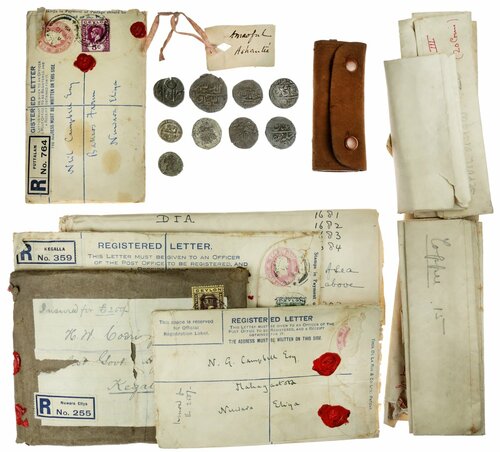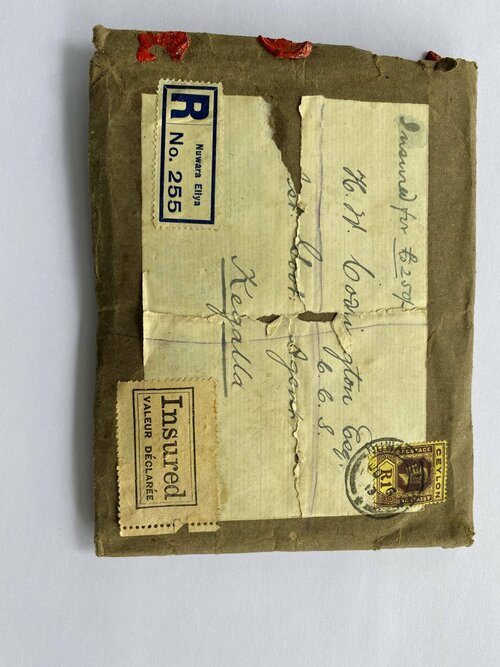Auction: 21125 - Spink Numismatic e-Circular 11: Indian & Islamic Coins
Lot: 7193
Sri Lanka (Ceylon), Dutch Colony, Persian coins used in Ceylon (8), together with handwritten letters and notes exchanged between N. G. Campbell of Nuwara Eliya to H.W. Codrington, Assistant Government Agent in Kegalla in original stamped envelopes; coins include: 'Abbas II (1642-66), 5-Shahi, Tiflis, AH1075, Abbasi, or contemporary copy, date and mint unclear, with 'VOC' countermark, 6.93g (similar to Ceylon, KM 49; Scho. 1285), another Abbasi, mint and date not visible, Sulayman I (1667-94), Abbasis (4), Tiflis, AH1088, Ardebil, with 'VOC' countermark with 'C' above for Colombo, 7.33g (Ceylon, KM 50; Scho. 1285e), Eravan, with Persian countermark, another, mint and date unclear, Mahmudi, Huwayza, AH1080, together with a Roman coin of Valens (364-78), mentioned in the documents, generally about fine to good fine, countermarks better (coins 9, stamped envelopes 3, several documents)
Scholten notes (pp.150-151, quoting Valentijn) that coins current in Colombo were the "large Persian Abbassi (5 shahis) for 22½ stivers, the common Abbassi (4 shahis) for 18 stivers and the Mahmudi or ½ Abbassi (2 shahis) for 9 stivers."
Although these were supposed to be counter-stamped with 'the Company's mark' after 1660 he goes on to note:
"According to the Resolution of the Council of Colombo dated Sep.4, 1688, there were many unstamped coins still in circulation. To prevent private persons for making a profit on the importation of such coins, notice was given that they must be presented for stamping before Sept. 30th. After that no unstamped coins would be current.
On Jan.27, 1691 another warning was published against false counter-stamped Abbassis made of lead, copper and tutenag that were in circulation. The prescribed weight was: 5 Shahipiece 9.232 grams; Abbassi 7.387 grams; Mahmudi 3.693 grams."
The coins in this lot are a perfect demonstration of this, as many are unstamped, one has a genuine Colombo stamp and is of correct weight, another is underweight and has a dubious stamp.
Part of a collection of coins formed by Mr Campbell, a tea planter of Nuwara Eliya in the early 20th century. He regularly correspondeded with Mr H. W. Codrington (famous for having later written 'Ceylon Coins and Currency,' published by Richards, Government Printer, Ceylon, 1924), which is still a standard reference work on the subject today. The contents of the evelopes had been coins purchased by Mr Campbell in the interior and sent to H.W Codrington for identification.
The correspondence, in which Codrinton identifies the coins, is an interesting read in its own right. The letters are dated between 1913 and 1915. The envelopes themselves had been stamped, sealed and sent by registered post, some marked 'insured for Rs. 250/-.'
Subject to 20% VAT on Buyer’s Premium. For more information please view Terms and Conditions for Buyers.
Sold for
£450
Starting price
£140







